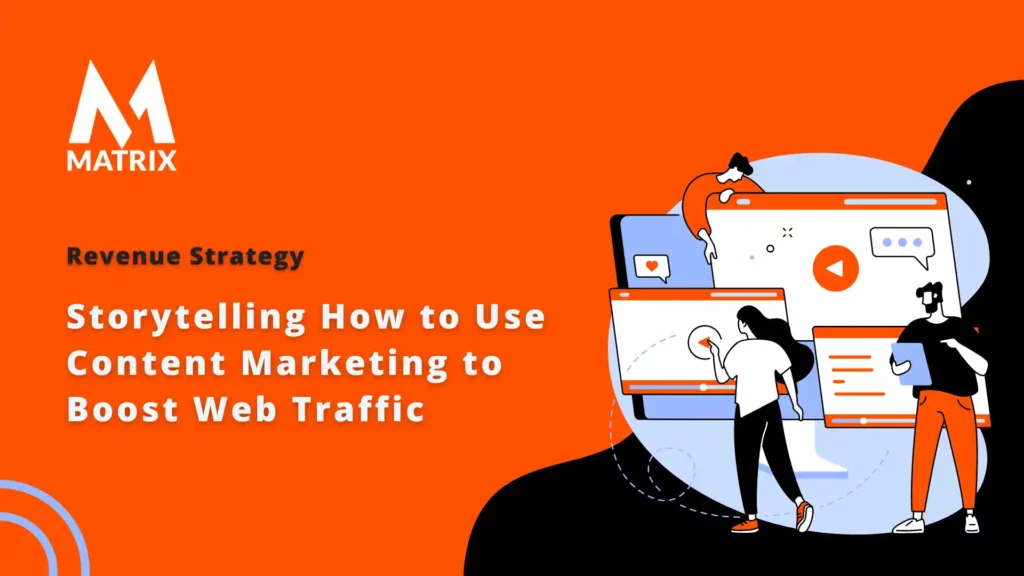How to use storytelling with your content marketing strategy to boost web traffic
Storytelling and how to use it in content marketing is an important part of any business. Storytelling is a common term that any business owner is aware of, but just a small minority knows the ropes.
How can a good story impact people and even businesses? How can we value and benefit from it? How should the audience absorb it to create the most unforgettable and precious experience for everybody?
You are lucky to find out all this and even more by reading the article. Please make yourself comfortable and start educating yourself with us.
What is the art of storytelling?
We will not surprise you by saying that storytelling is an indispensable part of art, history, economy, philosophy, etc. It is how life events are written and brands are created. But how do this magic and storytelling play such a fundamental role?
The trick lies in the words and images through which information is conveyed. A range of entertainment and education goals are achieved depending on how engaging it is. Storytelling is about the speed and credibility of content transmitted by word of mouth.
Respectively, if the question of storytelling art shows up, you know it is all about presenting valuable information. Something that will be responsive-oriented will make the “aha” moments within the audience and even touch them emotionally.
Brand storytelling works with the same principle. Most typically, the success factor is mainly related to content and social media marketing. With just a professionally designed caption and relevant, high-quality image, you are head and shoulders above those unsure about storytelling efficiency.
How can sharing stories empower your marketing strategy?
Emotional contact with storytelling

Your brand’s convincing voice can raise many emotions in your potential customers, help address problems and find solutions, and build brand loyalty and trust.
If these are one of your goals soon, consider content marketing as the most potent ingredient in the recipe of a real successful business. There are plenty of examples in various organizations’ lifetime history where storytelling proved efficient and easily automated.
However, we can no longer value fake and faceless businesses because they cannot establish a potential long-term relationship with audiences. Remember that emotional connection should openly come from both sides” your customers, obviously, and your brand to make storytelling work.
On the one hand, you present clearly why people should listen to you, buy your products, and order your services by bombarding them with a captivating and memorable description. And your clients have the right to speak about a high or low quality good and excellent or awful service, on the other.
Hence, a strong emotional bond comes in that is hardly breakable by any adverse events, circumstances, or anything else on your emotional response buyer journey.
Source of Inspiration
The digital era made it accessible for everyone to get attached and inspired to evolve. And once again, the scenario repeats itself where the source of this beneficial impact and encouragement comes from two parties.
By sharing stories, you always ask, “How productive is my brand?” “What do l have to offer?” “What can l do more.”
You educate others and get inspiration to make another user experience better than the current one. This gives you a broader insight into your business’s impact, profit, and prospects. There is more comprehension about your next steps and measures.
In the same venue, customers interested in your real story become motivated and flexible in everything you do. They notice a clear example or reflection of their struggles in your stories. Eventually, you will need to direct them to a path you need to take.
On top of that, customers deliver suggestions and concerns, helping you fix them. Not only do they relive the stories with you on the same wavelength, but they also propose an actual rate of what you do and how you can better improve.
Prompt action with storytelling
If we deal with professional marketing specialists with over a few years of storytelling experience, pushing the target audience toward action is a cinch.
Good storytelling can surprisingly scale up your client’s loyalty and motivate them to make rational decisions. When you talk about your business features in an emotional and trustworthy way, there is no room for hesitation left. Customers know exactly what they are engaging in.
Storytelling with data will always be more powerful when “woven into a story.” For instance, when the description of good covers all aspects and stages of production or even goes beyond, people are more likely to take action.
Online content is, actually, full of junk nowadays. So, only by spilling the tea about your business performance and presenting a clear image of your enterprise will it be possible to see clients taking robust actions.
Competitive impulse
The fierce competition we all observe in advertising is only possible with the essence of storytelling. Moreover, it should be compelling and outstanding enough if you want others to notice it. Otherwise, people will prefer another entity that has implied it earlier than you.
Incorporating stories and making your brand’s visuals prompt you to conceive extraordinary ideas in the most sophisticated and thoughtful way. Your competitive-oriented mindset determines all hows, and why’s of your meaningful texts and evokes a portion of interest.
When you master the art of storytelling, you finally set a vital function in force. What function, you wonder? The one that increases your potential customers’ conversions and drives more and more traffic to your website.
In other words, it ranks you among thousands of concurrents. This competitive streak forces marketers to go the extra mile if they want people to make conclusions and take action.
Distribution strategy and storytelling
Concise but clear communication with the help of storytelling is excellent. But what about the place and time when it should be delivered better?
Storytelling helps you determine the distribution strategy more quicker. An ideal concept of how it all should be seen and perceived by the audience supercharges your story management and triggers the dissemination mechanism.
You understand the concrete goal and outline the in-depth plan that segments your story and assigns it in the most entertaining and well-thought-out way. Besides, it encompasses all practical and construction activities at any stage of your business, from scratch or a distribution template.
You also accumulate the pattern of your collaboration with different authoritative media platforms that bring more potential customers to your business and ensure the worth of your verbal persuasion attempts.
What is needed for good storytelling?
Experienced storyteller
Regardless of this next statement’s platitude, it is the most crucial thing required for storytelling, the most integral one. Of course, we are talking about knowledgeable storytellers.
Even if you are the best marketer in the world, this label is not a guarantor of your writing skills. The same is when you are a business owner who executes his or her private organization on his initiative.
Without essential but fundamental journalistic/writing skills, you will not create valuable content for your website. It will merely lack essential buzzwords, news, and speech patterns for any story.
In any case, you will, at least, need to take a look at the essay writing service reviews. At first, it just compares the writer’s specializations and proficiency.
If you go through the most high-rated platforms, you will notice that Writing Judge is a definite leader of the entire business storytelling environment.
In addition to your awareness of what the writing services will bring, you will see how clear implications work verbally.
Data elements

Another dimension is data visualization, which can generate more benefits when sufficiently used than anyone imagines. By arranging a visual validation of your story, the human mind reckons the data’s composition and highlights patterns and outliers.
For an analyst’s mind, it is vital to compare data and get to grips with elements. Some ordinary customers do not seek that feasibility study, of course. However, just standard relevant data is needed for their enlightenment and satisfaction.
Thanks to the multiple advantages of storytelling underpinned by narratives, data, and visuals, you can enhance the existing brand value and authenticity.
Remember that to grab someone’s attention and focus this selective concentration on a specific entity, and you would want to use the visual components in your storytelling marketing.
Suppose you wonder how to demonstrate the steps of your investigations, findings, and monitoring. Empower your narrative with supporting facts. People believe in numbers and pictures more than just some eloquent phrases.
Adapting adjustments
Conveying your driving point to the target audience with some magic words is not a hard nut to crack. But the more significant thing you have to do is match your narrative with people’s expectations.
If a described story invokes no empathy and feelings from clients and, worse, if it doesn’t relate to their goals and priorities, the content will not impact anyone.
When you neglect adjustments to ensure your potential customers consume a desirable piece of information, you are doing nothing but just beating around the bush.
Therefore, ensuring how familiar visitors are with your business industry is the best solution. Trust us, examining the client’s needs and wants has never worsened any business. Learn what their background, beliefs, and expectations are about. And create an ultimately suitable story.
Conclusion on Storytelling
As you have probably understood so far from our meaningful long discussion on storytelling, this useful marketing tool will better you off from all aspects. To sum up, those mentioned above shape the user’s behavior making people loyal to your brand.
This cohesive narrative deepens your understanding of the market and opens the door for advancement. Also, it prolongs your brand’s existence if it is in danger or crisis and builds strong connection blocks for the prospective future of your organization.
Stories are a part of our everyday being. So, storytelling is a must everywhere, whether we talk about a commercial element or a non-commercial one.
It pushes us to read, encourages us to learn, and ultimately motivates us to take action. Without this essential marketer’s instrument, we can no longer imagine any successfully developed brand.
You definitely, have that clear destination in mind where you are moving on with your project/ business practice/ entrepreneurship/ etc.
So, just let storytelling guide you along this way to get you straight to that goal. Follow the instructions we have enlisted today and make the most of your interaction with the target audience.
We’re listening.
Have something to say about your thoughts on storytelling for your content marketing?
General FAQs
Why is storytelling important?
Storytelling is a unique way to develop an understanding, respect, and appreciation for other ideas and promote a positive attitude toward people from different perspectives.
Why is storytelling important for brands?
What is content marketing?
Content marketing is a strategic approach focused on creating and distributing valuable, relevant, and consistent content to attract and retain a clearly-defined audience — and, ultimately, to drive profitable customer action.
What makes a good storyteller?
A good storyteller will typically identify their two most salient points and bookend their story with them—they will open with an exciting anecdote to grab the audience’s attention. Then they will make sure the last thing they say is something that can resonate with the audience long after the story is over.

